Text and Photos By Jeffrey A. Rendall
PALM DESERT, CA -- "You don't see running streams in the desert very often," commented Desert Willow Golf Resort's General Manager, Rodney Young, when asked how he'd distinguish his Mountain View course from other desert layouts in the Coachella Valley.
That's certainly true, for if there was more running water in that type of environment, it probably wouldn't be a desert any longer. But as Young indicated, you will see several trickling streams on the Mountain View course, sibling to the slightly older Firecliff course at Desert Willow -- but much more of a resort-style offering. Though both layouts have a similar look and feel, the Mountain View holes are generally wider, more-friendly off the tee, have smaller greens, and of course, more running water.
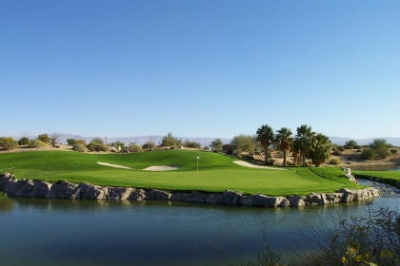 |
| Water guards the par five 6th hole's green. It's a pretty small target if you're going for it in two. |
There's more green grass to the eye on Mountain View, which provides a nice contrast to Firecliff's rather sandy and more visually intimidating presentation.
Both courses were designed by the team of Michael Hurdzan and Dana Fry, with PGA Tour Pro (and local resident at the time) John Cook acting as a consultant. Desert Willow Resort is owned by the City of Palm Desert (operated by Kemper Sports Management), and both courses feature plenty of the native flora and fauna of the desert environment, as well as excellent service you'd demand from an upscale resort in this locale.
For Cook, the Desert Willow Golf Resort project was a chance to work locally on one of his interests -- golf course design: "I was a local resident there, and I'd also been dabbling some in golf course design. I'd previously worked with the Hurdzan/Fry group, and when they were chosen for the project, I was pleased to be able to work close to home on an undertaking with the scope and environmental mission of Desert Willow."
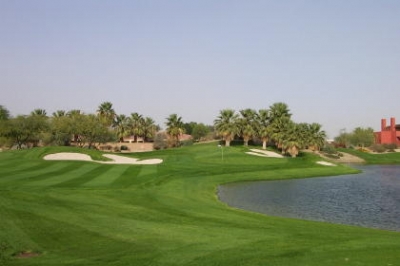 |
| It looks pretty benign here, but the par three 11th hole is a bear when the wind blows. |
Cook continues, "It was a real good fit, because I could actually spend a lot of time on site -- so when I wasn't playing on Tour, I went out there quite a bit. I spent a lot of time with the finish shapers, and with Dana Fry -- basically, half the days I was home, I was out there, either by myself in my Jeep, or out doing stuff and checking things out."
Cook's time contributed must have paid off. Having seen a good portion of the Palm Springs area golf offerings, Desert Willow's definitely on the top tier for quality, conditions and value. Palm Desert residents can play the courses for $45 (even during peak times), which has to rank up there with the best bargains you'll find anywhere. Seeing as Desert Willow sits adjacent to the Marriott Desert Springs Resort (and its two Ted Robinson courses), and Marriott's Shadow Ridge Resort (with a Nick Faldo designed layout), this grouping of golf layouts will rival any in the region -- including Indian Wells, Mission Hills and La Quinta's PGA West.
Cook says his physical proximity to the project added to its importance for him: "Since I'd lived in that area for such a long time, and it was going to have my name on it, and I was going to have to see a lot of those people who played it, I wanted to make sure things were right."
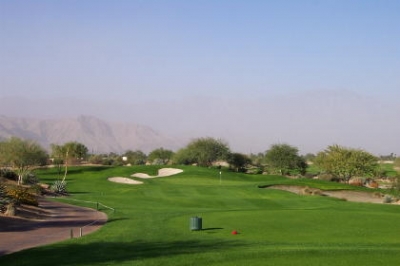 |
| It's pretty straightforward -- the par three 8th hole is rated Mountain View's easiest hole. Take advantage of it while you can. |
Desert Willow also presented the opportunity to incorporate the features he likes to see on a golf course. "I like to see a lot of options on the golf course, from the number of different tees that are put in, to test all abilities from the best touring professionals to the beginning type of player -- we don't want him to be too intimidated by going out and learning how to play."
"I certainly don't want to include anything goofy. My goal is to have people say, 'I enjoyed playing, I want to go back, I didn't lose a dozen balls or get my brains beat in -- and spent $500 doing it.' Some other courses in the desert are entirely too difficult for the average resort player. They're designed to challenge the best players in the game at tournament time, but what about the other 51 weeks of the year? That's just not smart planning," Cook added.
"I have no ego, so I don't care if people go out and shoot the best round of their lives on a course I've worked on -- I'd want them to come back and try to better it again the next time. I just don't see the point of beating people's brains in. Golf's supposed to be fun," Cook mused.
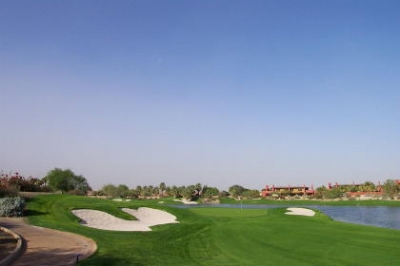 |
| Slicers beware of the approach shot to the 10th hole. Long and right make for a certain watery grave. |
Much to Cook's delight, the Mountain View course will certainly leave your cranium unscathed, and it's enjoyable, too. But Young says if it's played under the right circumstances, it'll be just as challenging as the Firecliff course: "I'd definitely say the Mountain View course is friendlier to the resort player, but from the back tees, it's still a tough test -- the reason being, its small greens. If you're hitting long or mid-irons into 'em, it's going to require some great shot-making to try and make birdies. We've had a few different professional level tournaments out here, and they've had all they can handle with that course."
The greens are indeed small, but there're some other elements that'll add some difficulty. Cook says he likes options around the greens, too: "I really like chipping areas -- that's a real nice defense on a golf course. I also like creative bunkering -- not big, flowery, four-leaf clover looking bunkers, but some nice traditional, kind of cut-to-grade type bunkers where the green might sit up just a little bit, and the bunkers are cut from the greens. And if you hit into a bunker, you'll have a chance to hit a good bunker shot -- but in order to make par, you've got to hit a great bunker shot. You know, make it a half-shot penalty if you missed the green, but give them a chance to get up and down."
"I don't like using a lot of rough, because it limits the type of shot that you can play from it. I'd rather add something that tests a guy's imagination rather than having him automatically grabbing a 60 degree sand wedge and lofting it up on the green. I want to see people playing some different shots with fairway woods and four irons, and if they still want to take out a lob wedge, they can try that, too," Cook said.
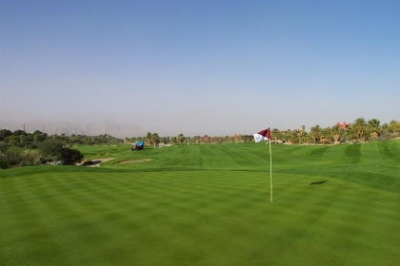 |
| You'll still see the native desert vegetation on the Mountain View Course--it just won't be as prominent as it is on the Firecliff Course. |
Another distinguishing feature of the Mountain View course (as well as the Firecliff course) is the waste areas. Many courses have them bordering fairways or tee boxes, but not around the greens. But you'll see some of that at Desert Willow -- and it can be quite a penalty to hit into one of them.
The fifth hole, a 227 yard par three, is a good example of where a greenside waste area figures prominently in play. Young describes it: "There's a waste area going down the right side of the hole, and up towards the green, it turns into a deep bunker. We're talking about enclosing some of those areas, because they're very hard to maintain, but also because they're extremely difficult to play out of. They'll still look like a waste area (if fixed), but they'll have playability more like a bunker."
The waste areas are part of seamlessly projecting the golf courses into the desert environment, which the City of Palm Desert insisted upon. Cook says it makes for a better golf course, but also helps the natural environment: "A lot of people complain about having golf courses ruining Mother Nature -- but I think it's just the opposite. Using Desert Willow as an example, the courses preserve and beautify the place, and care for it where anybody can enjoy it. If you get the environmental people together with the engineers, shaping crew, designers and architects to talk about how to go about it, I think you can actually enhance what's already there."
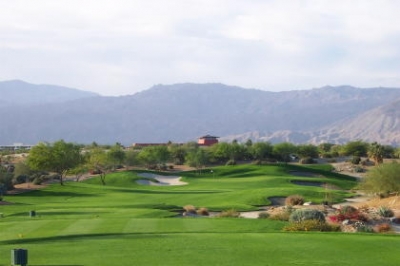 |
| At 227 yards, the par three 5th hole is long -- and if you miss in the wrong direction, its a very tough up and down. |
No doubt. Hole highlights on the Mountain View course include the fifth hole, which Young described above.
The par five sixth hole is another unique link. 'Only' 476 yards from the back tees, it's one of the shorter three shotters you'll ever see -- at least on the scorecard. Young says it's not as simple as it would appear: "Six is a great risk-reward hole. I've hit seven or eight iron into it, and it's a par five. But at the same time, if you hit it in the water, you'll make double. It's the shortest par five I've ever played in my life, but I've also posted a lot of big numbers there, because of that wall coming right across the front of the green."
Turning to the inward nine, eleven's a par three you won't soon forget, especially if the wind is blowing. 200 yards from the back tee with a full water carry, take an extra club (or two) if the wind is up -- or you'll certainly fall short. Take it from someone who knows. There is room to bail left, but that'll leave a difficult up and down.
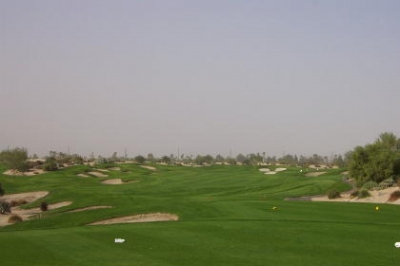 |
| The 448 yard, par four 14th hole is Mountain View's #1 handicap hole. |
Sixteen's a nice par four. 386 yards in length, it's a slight dogleg left with several options from the tee. Young says, "you've got to play the dogleg because of all the bunkers down the left side. You can try and carry them, but it's farther than it looks. And the second shot is tricky -- to a small, contoured green, and it's difficult to get it close."
The closing hole completes the experience. 538 yards in length (par five) with a slight dogleg left at the end, you'll need a solid drive placed between bunkers, then a carefully executed lay-up shot and a delicate pitch to leave a birdie try on the final hole. Or, if you've got the nerve, pull out a fairway wood and try to get it close in two. Options abound, just the way Cook likes it.
The Mountain View course is an enjoyable compliment to the Firecliff course at Desert Willow Golf Resort. They share similar good qualities, while hardly being carbon copies of each other. And if you've suddenly got a taste for some running water in the desert, the Mountain View course might just be the place to catch it.
Details:
Desert
Phone: (760) 346-7060; Toll Free: (800) 320-3323
FAX: (760) 346-7444
Website: www.desertwillow.com
General Manager: Rodney Young
Course Architects: Michael Hurdzan & Dana Fry
Design Consultant: John Cook
|
|
Yardage/Slope |
Rating |
|
Black |
6913/129 |
73.4 |
|
Blue |
6507/126 |
71.3 |
|
White |
6128/123/135 (L) |
69.6/75.7 (L) |
|
Gold |
5573/115/123 (L) |
67.7/72.1 (L) |
|
Red |
5040/116 |
68.9 |
Rates:
High Season rates -- $135-$165. Summertime -- $65-$75. Twilight and Super Twilight Rates: $65-$95.
Rates include carts with GPS and range privileges. Large natural grass range with putting green and short game practice area.
| Related Links | Comments on this article? | |
|
Maryland National Golf Club Hollow Creek Golf Club Rocky Gap Resort PB Dye Golf Club in Ijamsville Whiskey Creek Golf Club |
E-mail Jeff Rendall, Editor: jrendall@golftheunitedstates.com |











